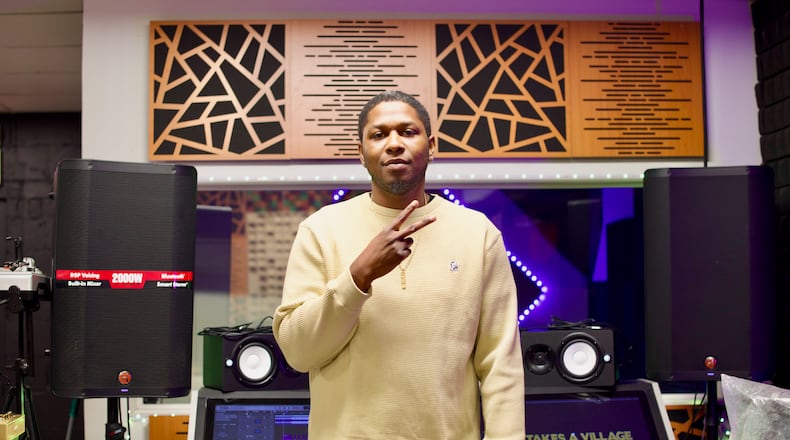Blanch and I stepped into It Takes a Village Studios, a multi-faceted, multimedia hub for musicians, artists and creators. Through the main area, we walked by a stage for performances — affixed with lighting and audio rigs — and, opposite that, a massive wooden green screen that resembles a halfpipe. With other equipment strewn about the space, it’s clear that what I anticipated to just be a music recording space was much more than that: It had the bones of an entire production house.
The main space, the elongated room with the stage, is currently under construction in some ways, although there have been shows there already: O’Shea the Wicked, a local underground rapper, had his debut record release there. Blanch himself has also put on a handful of shows on its stage.
While it remains aesthetically unfinished for the time being — with walls needing paint, sound-proofing installed, etc. — the pragmatic possibilities of It Takes a Village are already being realized.
In Studio A — assuming that’s the name, considering talk of a “Studio B” elsewhere in the space — a large Shure touchscreen mixing console is the centerpiece of the room, with formidable 200 watt speakers on either side. This is where most of the recording currently happens. Couches, chairs and a table fill out the rest of the room, with LED lighting adorning most of the walls. A soundproof booth shares a window with the console, and an instrument/drum closet houses equipment across the way.
Blanch, 27, has been recording and producing since he was 13; he’s been at It Takes a Village for the past year.
When the studio’s owner, King Tun, discovered Blanch at a Blind Bob’s show, he passed along his info, telling the rapper that he had a studio downtown.
“I’ve heard that for years from people… for years!” Blanch said. “But something told me to write to him. Something said, man, just see what he’s got to say.”
When the two took a tour of It Takes a Village, Blanch asked: “What do I have to do for you to give me a chance to work in a place like this?”
After King Tun gave him that chance, Blanch soon started taking care of production shoots, appointments, recording and filming, along with some of the logistical aspects that make ITAV run. He said he does it because it helps him improve his craft, while also teaching him the business side of the music business.
“I’ve never had a playground, and I finally have one,” Blanch said. “I have a media room. I have a whole studio. Anything I want to do is right here. And that’s what I’m trying to tell other people. If you come here, you book a session, all of this is to your advantage.”
The name It Takes a Village is also the essence behind the studio: it’s everybody working together toward a common goal, toward creative enlightenment. While the original intention of ITAV was music production, the other elements slowly formed around it — albeit many being music-related, like music videos and photography.
The space, which King Tun purchased years back, started completely empty; a village helped build it up.
Blanch talks about doing what he calls “industry nights” and “lock-in nights,” with the intention of pitching ideas to other artists, collaborating and giving feedback. He also has big plans for content creation, saying if an artist walks in to record or put on a show, they can walk out with at least a month’s worth of multimedia content to post online.
He’s been offered work at a high profile Springfield studio, but said he’d rather create something from the ground up, on his own terms.
“I’m really trying to build a platform for people my age; my friends don’t have that,” Blanch said. “Tun gave me a place to do that, so that’s what I’m doing here. I want to be able to build something and say that we built this at home.”
P the Emcee, an artist and longtime friend of the owner, walked into Studio A. He eventually acknowledged that he was wearing his own merch.
P said that Tun’s original intention for ITAV was for “artists in the city that have all this gift in them, that have a story to tell or something to create, to have a room to go into and be creative” — and to have access to facilities that may not otherwise be available.
At the back of the soundboard, Blanch installed an XLR cable, the one he came to the studio with. When he got up, he gave a smirk and headed into the sound booth to check levels.
Tucked inside an unassuming storefront and behind a partial barbershop decal on the window, It Takes a Village Studios is one of Dayton’s hidden gems.
Brandon Berry writes about the Dayton and Southwest Ohio music and art scene. Have a story idea for him? Email branberry100@gmail.com.
MORE INFO
What: It Takes a Village Studios
Where: 28 W. 5th St., Dayton
Online: itavstudios.com
About the Author




